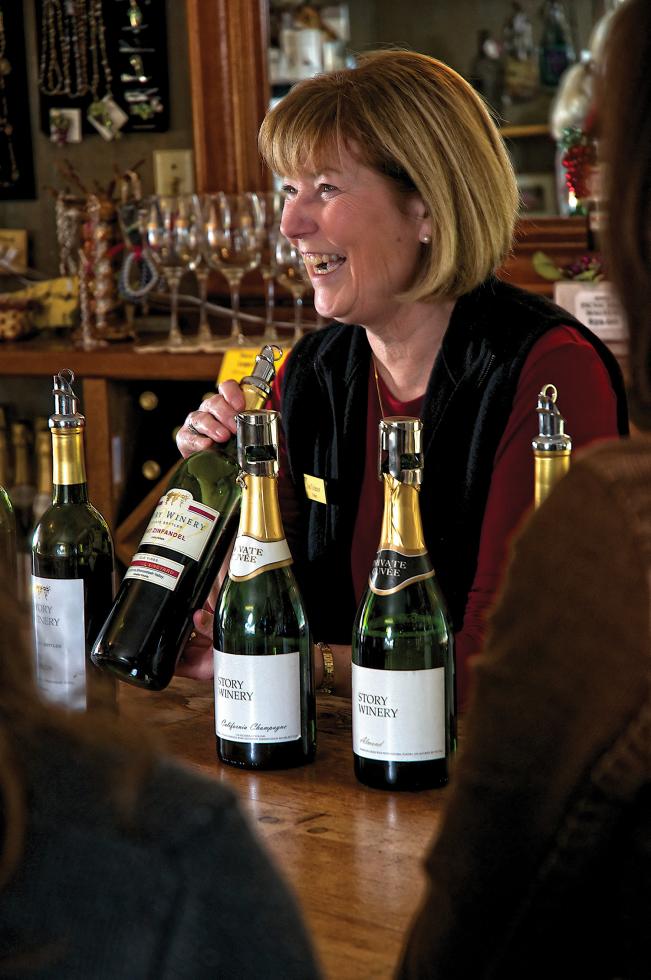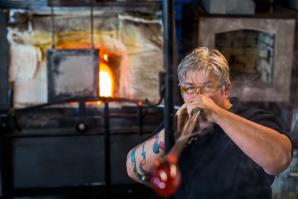When Gay Callan left her Bay Area sales job to grow grapes in the Sierra foothills in the early 1980s, people told her that she — a city slicker and a woman to boot — was crazy.
“Initially, I had no interest in making wine,” Callan says. She planted 65 acres of fruit on 800 acres in the foothills to diversify her family’s farming portfolio. She sold the fruit on contract to buyers, such as Stevenot Winery.
For a woman with a master’s degree in business, marketing and finance, the fruit was about money. But in less than a year, it also became her passion. She moved to Murphys to make wine and never looked back.
“All kinds of people would look at me and say, ‘You’ll never last,’” she says. But she hired a savvy foreman and a consultant, enrolled in the viticulture program at UC Davis and began custom crushing a bit of fruit at a little winery in Jackson.
In her first year, she produced 800 cases of Sauvignon Blanc, Merlot and Cabernet. Now, with her own crush pad, winery and tasting room, she’s producing 10 times that amount each year with three white varietals and at least six reds.
As Callan has grown her woman-owned business, Chatom Vineyards, in a male-dominated industry, she has watched her consumer demographics change as well.
“Initially, wine tasting had a mystique,” she says. “There was a perception that tasting rooms had a certain stigma. More men did the pomp and circumstance, and women didn’t know much about it. It’s amazing how women’s knowledge has changed.”
Across the hills in Plymouth, Jan Tichenor, the co-owner of Story Winery, has been witness to that same change in both the winery and the tasting room.
Female winery owners “are still few and far between, but there are more women whose husbands own wineries and who are getting more involved with the sales, buying and purchasing,” she says. “It’s amazing the number of women who come in and say, ‘Oh my gosh. You’re the owner?’ It establishes a different rapport.”
Nationwide, the number of female winery owners is growing, and today, 10 percent of winemakers are women, compared to just 1 percent a decade ago, according to the Wine Institute.
Tichenor, a former pharmacist, says she has jumped a lot of hurdles as a woman in a man’s profession. Her husband, Bruce, is the winemaker at Story. “I’m still introduced as the winemaker’s wife, not as the business owner,” she says.
Still, just as she has worked her way into the winery business, more women have made their way through the doors of her tasting room. She says they are increasingly knowledgeable about the product, assertive in their purchasing decisions and developing favor for California’s big reds where they might otherwise have chosen a dry white.
Wine industry experts estimate that roughly 60 percent of wine drinkers in the U.S. are women, and they match men as core drinkers, those who drink wine at least once a week.
Callan says she often sees men reaching for their wallets in her
tasting room, but “nine times out of 10 it’s the woman who is
making the decision,” she says. “I am finding that more women are
doing more of their homework; they aren’t uneducated, and they
are less indecisive. It seems like there is more confidence.”
Confidence has certainly been a key factor in Napa where three women have launched Toolbox Wine Co., a boutique wine label with products targeted toward the construction industry.
“Instead of going with an estate name, we decided to support a trade industry,” says Katie Hamilton Shaffer, Toolbox founding partner and quality assurance manager. “We reached out to our local Home Depot and Snap-on tools to have wine tastings at their building demonstrations. Women want to support us, but the construction and general contracting firms are coming to us and wanting to use our wines for their giveaways and events.”
Until recently, wine was generally marketed as gender-neutral. Over the past couple years some brands targeting women have entered the market, but those women-specific products can backfire with male consumers, as Callan can attest. Proceeds from her She Wines Red support local heart disease charities, but the wine’s name, along with its label depicting a woman sipping wine, has deterred male buyers, who tell Callan ‘I can’t drink that because it’s wine for women.’ The same can be said for her She Wines White, which benefits breast cancer research.
Shaffer says Toolbox can avoid that alienation because the products are a hit with both genders.
“It’s kind of that woman-power, do-it-yourself, concept,” she says. “It’s promoting to women that you can DIY and have a good time.”
Shaffer notes that women like the fact that Toolbox is owned and produced by women, meanwhile the product appeals to men because it targets a male-dominated industry and is cropping up at their trade events. The company’s whimsical label and tongue-in-cheek marketing appeals to both genders.
“Women are 60 percent of wine consumers, but it’s perceived that men will open their pocketbooks a little bit more,” Shaffer says. “I think it has really equaled out, and I’m such a tomboy that I want to appeal to everybody. I want to open a bottle of Toolbox with the guys and serve it to the girls who come in for their bachelorette parties.”
Recommended For You

Wine Winner
How Dr. Grover Lee went from the pharmacy to the vineyard
Imagine you’re a successful businessman, but what you really want to be is a professional baseball player. You’re so sure of yourself that you begin spending nights and weekends studying and training as if Major League Baseball will soon be calling. And then they actually do, and at your first at-bat, you clear the bases.
That’s pretty much how things happened when Granite Bay pharmacist Dr. Grover Lee decided to become an award-winning winemaker.




